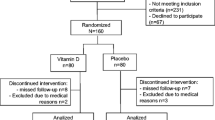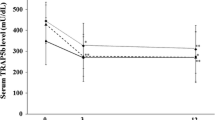Summary
The objective of this study was to identify subjects in whom vitamin K has an effect on markers for calcium and bone metabolism and to detect hitherto-unnoticed correlations between vitamin K-induced changes in these markers. Participants in our studies were apparently healthy women, in whom we measured serum-immunoreactive osteocalcin (irOC) before and after adsorption to hydroxylapatite; total serum alkaline phosphatase (T-AP) and bonespecific alkaline phosphatase (B-AP); and fasting urinary calcium and creatinine. We describe a trial among 145 women who were treated with vitamin K (1 mg/day) for 2 weeks, and a prospective placebo-controlled trial among two groups each of 70 postmenopausal women with a treatment period of 3 months. It turned out that in elderly women vitamin K induced increased levels of serum irOC with a high affinity for hydroxylapatite (irOCbound), whereas that with low affinity (irOCfree) remained unaffected. In placebo-treated women the ratio irOCfree/irOCbound shifted from 0.38 to 0.65 around the 50th year of age. This shift was not found in vitamin K-treated women. After 3 months of treatment the vitamin K-induced changes in irOCbound were correlated with changes in B-AP, whereas irOCfree was correlated to urinary calcium excretion. In fast losers of urinary calcium vitamin K induced a 30% decrease of calcium excretion. The hypothesis is put forward that irOCbound may be a marker for bone formation, that serum irOCfree may be a marker for bone resorption, and that the serum irOCfree/irOCbound ratio may become a marker for skeletal remodeling. It is concluded that vitamin K administration may help to reduce urinary calcium loss in postmenopausal women, notably in the fast losers of calcium. The ratio irOCfree/irOCbound provides more information than total irOC and may become a practical marker for bone metabolism.
Similar content being viewed by others
References
Vermeer C (1990) Gamma-carboxyglutamate-containing proteins and the vitamin K-dependent carboxylase. Biochem J 266:625–636
Suttie JW (1985) Vitamin K-dependent carboxylase. Annu Rev Biochem 54:459–1177
Olson RE (1984) The function and metabolism of vitamin K. Annu Rev Nutr 4:281–337
Furie B, Furie BC (1988) The molecular basis of blood coagulation. Cell 53:505–518
Nakagawa Y, Abram V, Kézdy FJ, Kaiser ET, Coe FL (1983) Purification and characterization of the principal inhibitor of calcium oxalate monohydrate crystal growth in human urine. J Biol Chem 258:12594–12600
Price PA (1988) Role of vitamin K-dependent proteins in bone metabolism. Annu Rev Nutr 8:565–583
Hauschka PV, Lian JB, Cole DEC, Gundberg CM (1989) Osteocalcin and matrix Gla protein: vitamin K dependent proteins in bone. Phys Rev 69:990–1047
Gijsbers BLMG, van Haarlem LJM, Soute BAM, Ebberink RHM, Vermeer C (1990) Characterization of a Gla-containing protein from calcified human atherosclerotic plaques. Arteriosclerosis 10:991–995
Vermeer C, Hamulyák K (1991) Pathophysiology of vitamin K deficiency and oral anticoagulants. Thromb Haemostas 66:153–159
Knapen MHJ, Hamulyák K, Vermeer C (1989) The effect of vitamin K supplementation on circulating osteocalcin (bone Gla-protein) and urinary calcium excretion. Ann Int Med 111:1001–1005
Behr W, Barnert J (1986) Quantification of bone alkaline phosphatase in serum by precipitation with wheat-germ lectin: a simplified method and its clinical plausibility. Clin Chem 32:1960–1966
Nordin BEC (1978) Diagnostic procedures in disorders of calcium metabolism. Clin Endocrinol 8:55–67
Delmas PD, Stenner P, Heinz W, Wahner K, Mann KG (1983) Increase in serum bone gamma-carboxyglutamic acid protein with aging in women. Implications for the mechanism of age-related bone loss. J Clin Invest 71:1316–1321
Epstein S, Poser JW, McClintock R, Johnston CC, Bryce G, Hui S (1984) Differences in serum bone gla protein with age and sex. Lancet 1:307–310
Catherwood BD, Marcus R, Madvig P, Cheung AK (1985) Determinants of bone gamma-carboxyglutamic acid-containing protein in plasma of healthy aging subjects. Bone 6:9–13
Ismail F, Epstein S, Pacifici R, Droke D, Thomas SB, Avioli LV (1986) Serum bone Gla protein (BGP) and other markers of bone mineral metabolism in postmenopausal osteoporosis. Calcif Tissue Int 39:230–233
Price PA, Williamson MK, Lothringer JW (1981) Origin of the vitamin K-dependent bone protein found in plasma and its clearance by kidney and bone. J Biol Chem 256:12760–12766
Akedo Y, Hosoi T, Inoue S, Ikegami A, Mizuno Y, Kaneki M, Nakamura T, Ouchi Y, Orimo H (1992) Vitamin K2 modulates proliferation and function of osteoblastic cells in vitro. Biochem Biophys Res Commun 187:814–820
Plantalech L, Guillaumont M, Vergnaud P, Leclercq M, Delmas PD (1991) Impairment of gamma carboxylation of circulating osteocalcin (bone Gla protein) in elderly women. J Bone Miner Res 6:1211–1216
Nordin BEC, Heaney RP (1990) Calcium supplementation of the diet: justified by present evidence. Br Med J 300:1056–1060
Akiba T, Kurihara S, Tachibana K, Kuwahara M, Sakamoto H, Yoneshima H, Marumo F (1991) Vitamin K (K) increased bone mass (BM) in hemodialysis patients (Pts) with low-tumover bone disease (LTOBD). J Am Soc Nephrol 2:608
Fiore CE, Tamburino C, Foti R, Grimaldi D (1990) Reduced bone mineral content in patients taking oral anticoagulant. South Med J 83:538–542
Resch H, Pietschmann P, Krexner E, Willvonseder R (1991) Decreased peripheral bone mineral content in patients under anticoagulant therapy with phenprocoumon. Eur Heart J 12:439–441
Author information
Authors and Affiliations
Rights and permissions
About this article
Cite this article
Knapen, M.H.J., Jie, KS.G., Hamulyák, K. et al. Vitamin K-induced changes in markers for osteoblast activity and urinary calcium loss. Calcif Tissue Int 53, 81–85 (1993). https://doi.org/10.1007/BF01321883
Received:
Revised:
Issue Date:
DOI: https://doi.org/10.1007/BF01321883




